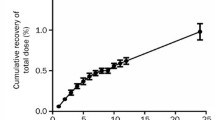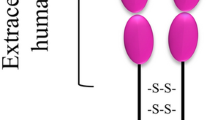Abstract
Purpose. The effect of elevated serum alpha-1 -acid glycoprotein (AAG) concentrations on the steady-state serum and brain levels of imipramine and its metabolite desipramine was assessed. This was approached using a novel strain of transgenic mice whose basal endogenous serum AAG levels were 8.6-fold elevated over normal.
Methods. Imipramine was administered by s.c. infusion or i.p. injection into transgenic and control mice. After drug administration, serum and whole brain were harvested and analyzed for imipramine and desipramine concentrations. Equilibrium dialysis was performed to determine the extent of imipramine protein binding in transgenic and control sera. Serum and brain samples were analyzed for imipramine and desipramine content by an established HPLC method with UV detection.
Results. At steady-state, the mean serum imipramine concentration was significantly higher in transgenic mice than in control mice (859.0 vs. 319.9 ng/ml). In contrast, the mean steady-state brain imipramine concentration was significantly lower in transgenic mice (3,862.6 vs. 7,307.7 ng/g). Similarly, in transgenic mice, the mean steady-state serum desipramine concentration was significantly higher (176.7 vs. 39.0 ng/ml) while the mean brain desipramine concentration was lower (243.0 vs. 393.5 ng/g). The serum unbound fraction of imipramine was 3-fold lower in transgenic mice (0.03 vs. 0.09).
Conclusions. Elevated serum AAG impedes the transport of imipramine and desipramine into the brain. Further, in the presence of elevated serum AAG levels, imipramine and desipramine concentrations in the brain did not correlate with their respective concentrations in the serum.
Similar content being viewed by others
REFERENCES
M. H. Bickel. Binding of chlorpromazine and imipramine to red cells, albumin, lipoproteins and other blood components. J. Pharm. Pharmacol. 27:733–738 (1975).
C. B. Nemeroff, K. R. Krishinan, D. G. Blazer, D. L. Knight, D. Benjamin and L. R. Meyerson. Elevated plasma concentrations of alpha-1-acid glycoprotein, a putative endogenous inhibitor of the tritiated imipramine binding site in depressed patients. Arch. Gen. Psychiatry 47:337–340 (1990).
W. A. Kehoe, J. A. Kwentus, W. B. Sheffel and A. F. Harralson. Increased alpha-1-acid glycoprotein in depression lowers free fraction of imipramine. Biol. Psychiatry 29:489–493 (1991).
C. L. DeVane, J. W. Simpkins and S. A. Stout. Cerebral and blood pharmacokinetics of imipramine and its active metabolite in the pregnant rat. Psychopharmacology 84:225–230 (1984).
M. van Wijk and J. Korf. A quantitative study in the rat on the relationship between imipramine levels in brain and serum. Psychopharmacology. 76:48–51 (1982).
Y. Sato, S. Shibanoki, M. Sugahara and K. Ishikawa. Measurement and pharmacokinetic analysis of imipramine and its metabolite by brain microdialysis. Br. J. Pharmacol. 112:625–629 (1994).
C. L. DeVane and C. R. Jarecke. Cyclic antidepressants. In W. E. Evans, J. J. Schentag and W. J. Jusko (eds.), Applied Pharmacokinetics: Principles of Therapeutic Drug Monitoring, Applied Therapeutics, Vancouver, 1992, pp. 33-1–33-47.
D. J. Greenblatt, E. M. Sellers and J. Koch-Weser. Importance of protein binding for the interpretation of serum or plasma drug concentrations. J. Clin. Pharmacol. 22:259–263 (1982).
P. Riant, S. Urien, E. Albengres A. Renouard and J. P. Tillement. Effects of the binding of imipramine to erythrocytes and plasma proteins on its transport through the rat blood-brain-barrier. J. Newrochem. 51:421–425 (1988).
S. D. Yoo, J. W. Holladay, T. K. Fincher, H. Baumann and M. J. Dewey. Altered disposition and antidepressant activity of imipramine in transgenic mice with elevated alpha-1-acid glycoprotein. J. Pharmacol. Exp. Ther. 276:918–922 (1996).
M. J. Dewey, C. Rheaume, F. G. Berger and H. Baumann. Inducible and tissue-specific expression of rat alpha-1-acid glycoprotein in transgenic mice. J. Immunol. 144:4392–4398 (1990).
S. A. Stout and C. L. DeVane. Quantification of imipramine and its major metabolites in whole blood, brain and other tissues of the rat by liquid chromatography. Psychopharmacology 84:39–41 (1984).
S. D. Yoo, J. W. Holladay, T. K. Fincher and M. J. Dewey. Rapid microsample analysis of imipramine and desipramine by reversedphase high performance liquid chromatography with ultraviolet detection. J. Chromatogr. 668:1338–342 (1995).
W. D. Wessinger. Chronic administration of pencyclidine: pharmacokinetic comparison of intravenous and subcutaneous infusions in Sprague-Dawley rats. Drug Metab. Dispos. 19:719–721 (1991).
W. Daniel, L. Danek, L. Janczar, H. Nocon and M. Melzacka. Regional distribution of imipramine, desipramine and specific [3H]desipramine binding sites in the rat brain after acute and chronic treatment with imipramine. J. Pharm. Pharmacol. 43:31–35 (1991).
M. Qin, M. Nilsson and S Øie. Decreased elimination of drug in the presence of alpha-1-acid glycoprotein is related to a reduced hepatocyte uptake. J. Pharmacol. Exp. Ther. 269:1176–1181 (1994).
K. Brøsen and L. F. Gram. First-pass metabolism of imipramine and desipramine: impact of the sparteine oxidation phenotype. Clin. Pharmacol. Ther. 43:400–406 (1988).
S. Sindrup, K. Brøsen and L. F. Gram. Nonlinear kinetics of imipramine in low and medium plasma level ranges. Ther. Drug Monit. 12:445–449 (1990).
Author information
Authors and Affiliations
Rights and permissions
About this article
Cite this article
Holladay, J.W., Dewey, M.J. & Yoo, S.D. Steady-State Kinetics of Imipramine in Transgenic Mice with Elevated Serum AAG Levels. Pharm Res 13, 1313–1316 (1996). https://doi.org/10.1023/A:1016005529420
Issue Date:
DOI: https://doi.org/10.1023/A:1016005529420




